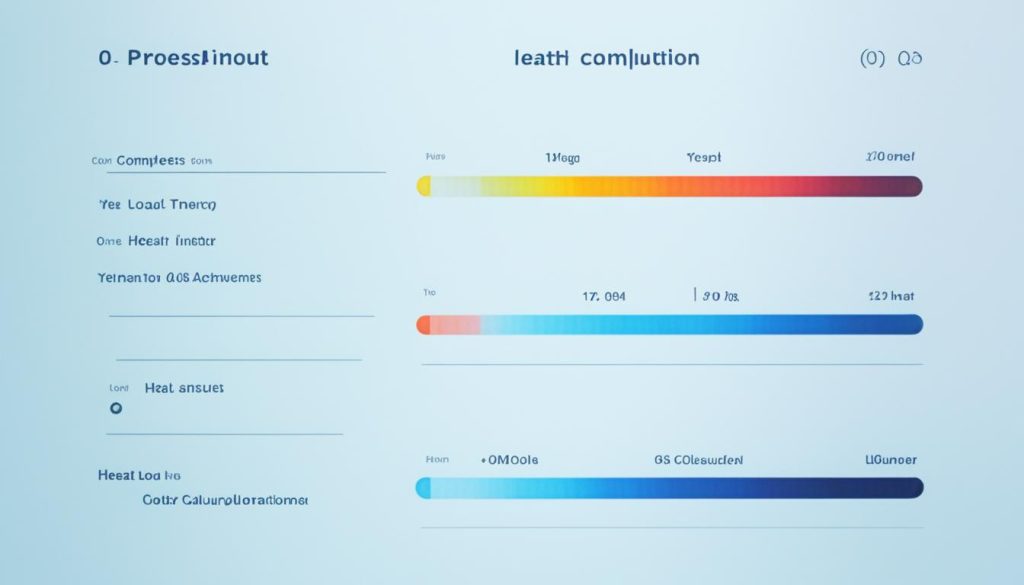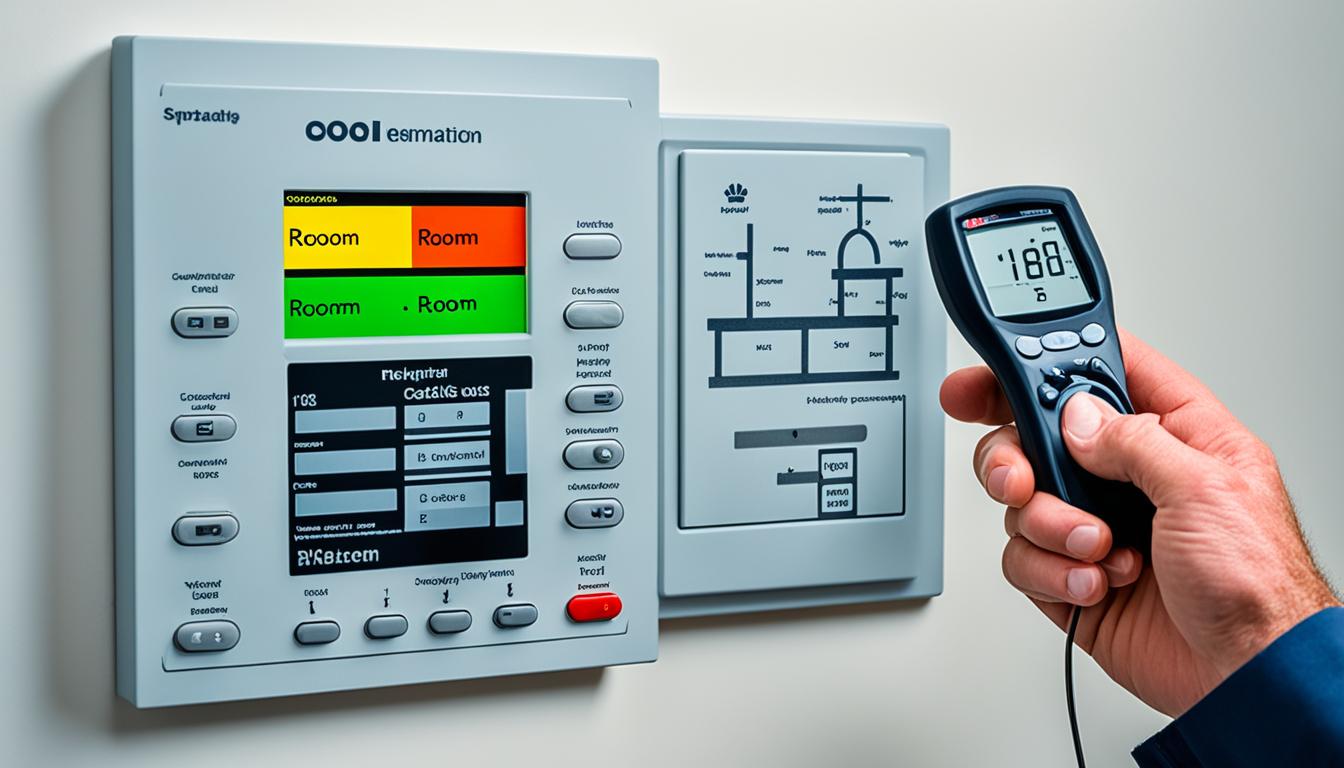Getting HVAC systems to work well in homes and offices begins with figuring out the right heat load. This first step is key in choosing the best system for cooling.
Our Heat Load Calculation Guide is here to help. It will show you how to accurately work out the heat load. This makes sure your HVAC works efficiently, saving energy and making your space comfy.
Key Takeaways
- Accurate heat load calculations are crucial for HVAC system efficiency.
- Understanding the heat load helps in selecting the right cooling and heating solutions.
- Factors affecting heat load include climate, building insulation, and occupancy patterns.
- Various methods, including manual calculations and software tools, exist for calculating heat load.
- Proper HVAC sizing prevents energy wastage and ensures comfort.
What is Heat Load?
Heat load is vital for HVAC systems. It’s the amount of heating or cooling needed. This helps keep rooms at the right temperature and uses energy wisely.
Definition of Heat Load
The heat load definition is all about how much heating or cooling an area needs. It looks at things like insulation, windows, and the weather outside. By looking at these details, we can figure out what HVAC equipment is needed for the job.
Importance in HVAC Systems
Getting the building heat load calculation right is important. It’s key for making the HVAC system work well. In places with harsh weather, the system must keep up. A right-sized system keeps things comfy and saves energy. It also makes the system last longer and costs less to run.
Factors Affecting Heat Load Calculation
It’s key to know what factors impact heat load calculation for good HVAC design. The weather where a building is, how well it’s insulated, its windows’ size and count, and how it’s used are all key. Doing the math right makes sure the system works well.

Climate Region
The climate impact on heat load is big. Places with big heat changes need strong HVACs to stay comfortable. For example, cold places need more heating, making the heat load calculation different.
Building Insulation
The insulation quality matters a lot. Good insulation keeps the heat in or out, helping the HVAC work better. But, bad insulation makes energy use and cost go up.
| Insulation Type | Effectiveness | Impact on Heat Load Calculation |
|---|---|---|
| Fiberglass | High | Reduces heat transfer, lowers energy consumption |
| Spray Foam | Very High | Maximizes thermal insulation, highly efficient |
| Cellulose | Moderate | Moderately effective at reducing heat transfer |
Number and Size of Windows
Window heat gain impacts heat load too. Big windows and those not well insulated use more heat and cool. Double-glazed and special windows help use less energy.
Occupancy and Usage Patterns
Who’s in the building and what they do also matter. Everybody and electronics make the place warmer, making HVAC systems work harder. So, we need to think about this when figuring out how much heat a home needs.
Methods of Calculating Heat Load
To make HVAC work better, calculating heat load right is key. We use different ways to figure out heat load, from doing the math by hand to using special computer programs. Each way has good points and some drawbacks. Knowing them helps pick the best one for your job.
Figuring things out by hand helps you understand what a heating or cooling system needs. First, you look at all the electricity it uses. This basic way gives a basic idea of how much heat there might be. It looks at things like the amount of stuff moving through the system, how heat affects it, and changes in temperature. This method is good for a quick look but may not be perfect for big or tricky systems.
But there are computer tools made just for this job. They offer a clearer, more precise look and deal better with lots of details. They’re quick, too, looking at a lot of info at once. These tools think about things like how good the insulation is, heat from windows, and how many people are around. Big names in this kind of software are Carrier’s HAP and Trane’s TRACE 700. They work in homes and at work.
Here’s a table showing the main points of each way to figure out heat load:
| Method | Advantages | Limitations |
|---|---|---|
| Manual Calculation | Easy to perform, no special tools needed, good for initial assessments | Less accurate, labor-intensive, not suitable for complex systems |
| Software Tools | Highly accurate, handles complex variables, fast processing | Requires specialized software, potential learning curve, ongoing costs |
Using tools to understand HVAC better makes sure your systems fit right and work well all year. Whether you do the math by hand or use fancy software, knowing and using the right method matters. It’s how we get the correct amount of heat load.
Heat Load Calculation Formula
It’s vital to know the heat load calculation formula. It helps find out how much cooling a space needs. To figure this out, we use the mass flow rate, specific heat capacity, and temperature difference.

Basic Calculation Formula
The main equation for heat load is:
Q = ṁ × Cp × ΔT
- Q: Heat load in BTUs
- ṁ: Mass flow rate in pounds per hour
- Cp: Specific heat capacity in BTUs per pound per degree Fahrenheit
- ΔT: Temperature differential in degrees Fahrenheit
You can change the results to fit the needed BTUs by doing some conversions.
Example Calculation
Let’s look at an example using the heat load formula:
| Variable | Value |
|---|---|
| Mass flow rate (ṁ) | 500 lbs/hr |
| Specific heat capacity (Cp) | 0.24 BTUs/lb°F |
| Temperature differential (ΔT) | 20°F |
| Heat Load (Q) | Q = 500 × 0.24 × 20 = 2,400 BTUs |
Using the numbers given, we see that the heat load is 2,400 BTUs. This simple example shows how to figure out your cooling needs. It helps make sure your HVAC system works well.
Using Heat Load Calculation Software
Heat load calculation software boosts the precision and work speed of your HVAC designs. These tools have advanced features. They work great for detailed plans and figuring out how much energy you need. This goes for homes and businesses alike.

Benefits of Software Tools
Using HVAC design tools has big advantages. They make sure your system isn’t too big or too small. So you don’t waste money. They also cut down the time and work on tricky math. And, because they’re always updated, you stay with the newest rules and standards.
- Increased Accuracy: Modern energy load calculation software integrates complex algorithms to provide precise results.
- Time Efficiency: Automation of tedious calculations allows for quicker project turnaround.
- Regulatory Compliance: Continuous updates ensure alignment with current industry regulations and standards.
Popular Heat Load Calculation Software
A number of strong heat load calculation software is out there. They meet various needs and levels of complexity. Let’s check out some top picks:
| Software | Key Features | Target Audience |
|---|---|---|
| Carrier HAP (Hourly Analysis Program) | Advanced modeling, detailed energy analysis, and compliance checks | Professionals in large commercial projects |
| Trane Trace 700 | Comprehensive load, energy, and economic analysis | Engineers and HVAC designers |
| EnergyPlus | Open-source energy modeling, highly customizable | Researchers and advanced users |
| CoolCalc | Simplified residential load calculations, user-friendly | Contractors and homeowners |
When you add these tools to your work, you improve how you handle the detailed energy work. This helps your systems work better and save more energy.
Residential Heat Load Calculation
Getting a home’s heat load calculation right is key for effective heating and cooling. The following steps will help you through this important process:
Steps to Calculate
First, collect info about your house. This includes its size, how it’s insulated, and the local weather. This data is vital for choosing the right size HVAC for your home.
- Measure each room to find the total living space volume.
- Check the insulation on walls, roof, and floors using R-values.
- Not down windows details, focusing on their energy efficiency.
- Think about the family size and what activities they do each day.
- Write down the heat produced by home appliances and electronics.
Common Challenges
When figuring out your heat load, some issues can throw off the results. Here are a few to watch for:
- The weather can change a lot, so it’s best to look at past data and local weather forecasts.
- Using different building materials can change how well they insulate. Stick to standard materials to keep things accurate.
- Figuring out how well insulation works can be hard without the right tools. Knowing exact R-values is key.
Solving these problems makes picking the right HVAC size easier. This leads to a home that’s more comfy and uses energy better.
Commercial Heat Load Calculation
Figuring out how much energy a business needs is harder than for a home. It’s because businesses are bigger, use energy in different ways, and have more things that make heat. A detailed process is key. This makes sure the heating and cooling systems work well and save money.

Unique Considerations
Calculating heat loads for businesses is different. You have to think about many special things:
- Building Usage: The kind of business changes the heating and cooling needs. For example, a restaurant and a store don’t need the same energy because of their different equipment.
- Internal Heat Gains: Things like computers, lights, and machines make the building warmer. It’s important to measure this heat carefully.
- Occupancy Levels: More people in a building at different times affects the heat needs. Knowing when it’s busiest helps keep everyone comfy without wasting energy.
Best Practices
Using the right methods is crucial for calculating heat loads in businesses. This promises they’re done right and save money:
- Professional Analysis: Trust experts to do the math. They have the tools and skills for even the most challenging jobs.
- Comprehensive Data Collection: Take detailed notes on the building’s size, how well it’s insulated, types of windows, and what makes heat inside. This approach leads to correct calculations.
- Use of Advanced Software: Pick advanced software made for this kind of calculation. It checks everything and helps design the best HVAC systems.
By following these steps, you ensure your business uses energy wisely. This helps lower costs and keep everyone happy.
Cooling Load Calculation
The cooling load calculation is very important when making or updating air conditioning systems. It makes sure the AC works well by finding the right cooling needed. Doing this means the AC will keep indoor temperatures comfy, especially in summer.
Many things affect how much cooling a place needs. This includes the sun, how much heat is made inside, and what the building is made of. By looking into these aspects, the air conditioning efficiency gets a lot better.

Knowing about the windows, attics, and insulation quality also matters. Good calculations stop the AC from working too hard or not hard enough. This helps it last longer and work its best.
Here are some common questions about cooling load calculation:
- What are the key factors influencing the cooling load calculation?
- How does sun exposure impact maintaining indoor temperatures?
- Why is air conditioning efficiency important for energy savings?
- Can cooling load calculations help in selecting the right air conditioner size?
- What tools and methods are used for accurate cooling load calculations?
- How often should cooling load calculations be updated?
- What role does building insulation play in the overall cooling load?
- Are there specific software tools recommended for home cooling load calculations?
- How do internal heat gains affect the cooling load?
- Can proper cooling load calculations extend the lifespan of my HVAC system?
Heating Load Calculation
Figuring out how much heat you need is key for staying warm in winter. You need to know the differences between cooling and heating needs. This way, your heating system can work spot on.
Key Differences from Cooling Load
Cooling and heating load calculations differ a lot. One big thing is the outside temp. Heating loads look at keeping warm in cold weather. Cooling loads are about staying cool in the heat. They also think about how well your place keeps the temperature in and your heating system’s power.
Calculation Example
Let’s look at a simple heating load calculation. Imagine you have a room that’s:
- Area: 500 sq ft
- Ceiling Height: 10 ft
- Insulation: Moderate
- Outdoor Temperature: 30°F
- Desired Indoor Temperature: 70°F
You can find the heating load using this formula:
| Parameter | Value | Explanation |
|---|---|---|
| Temperature Difference | 40°F | 70°F(inside) – 30°F(outside) |
| Volume | 5000 cu ft | 500 sq ft * 10 feet high |
| Heat Loss Factor | 0.7 | Quality of insulation matters |
| Heating Load | 140,000 BTUs/hour | Volume * Temp Difference * Heat Loss Factor |
In our example, we find the need for 140,000 BTUs to stay warm. Accurate calculations help pick the right heating system size and keep things efficient.
Energy Load Calculation
Learning how to do an energy load calculation is important for making your HVAC system work better. This process looks at what your heating and cooling needs are. Knowing this helps make your system use the right amount of energy.
Understanding Energy Loads
Energy loads are all the heating and cooling your space needs. You figure this out by looking at the space’s size, insulation, and the weather. By doing a detailed energy load calculation, you make sure your HVAC can keep you warm in winter and cool in summer without using too much energy.
How to Measure
You can measure energy loads in simple or complex ways. Simple ways just look at the space’s size and how well it’s insulated. But, complex methods use special software. This software looks at more details, like how many people are usually in the space. These advanced methods make the measurements more accurate. This helps your HVAC be more efficient.
Here’s an overview of some parameters often included in energy load calculations:
| Parameter | Description |
|---|---|
| Square Footage | Measures the area to be conditioned by the HVAC system. |
| Insulation Value | Evaluates the thermal resistance of building materials. |
| Climate Zone | Affects the baseline heating and cooling needs based on location. |
| Occupancy | Determines internal heat gains due to people and activities. |
Common Mistakes in Heat Load Calculation
Getting your HVAC system’s heat load right is very important. Mistakes make your system too big or too small. This can lead to wasted money and energy. Let’s look at the mistakes people often make.
Misestimation of Insulation Quality
One big mistake is not gauging insulation right. If your insulation is not perfect, it could mean your HVAC system is wrong-sized. This lets too much heat in or out, messing with your home’s temperature. It’s key to look at how good the insulation is in walls, ceilings, and floors. This helps figure out the exact BTUs you need for heating or cooling.
Ignoring Occupant Heat Gain
A big error is not counting the heat people make. Everyone gives off heat, altering your heat load, especially in busy spots. You need to think about how many people are there and what they’re doing. This makes your HVAC planning more precise. It’s crucial for stopping system mistakes that lead to wasted energy.
Conclusion
It’s vital to get heat load calculations right for your HVAC system. This guide has shown why it’s key. It helps make sure your space stays at the right temperature, whether it’s at home or work. We’ve covered how things like weather and how well a building holds heat influence this.
When you do these calculations well, you save on energy and costs. You can make your HVAC work efficiently. By using the right steps and tools we talked about, you’ll figure out the best setup for your needs. This not only saves money but also keeps your system working well for longer.
Knowing common mistakes is also helpful. It includes guessing the wrong insulation quality and forgetting about how people inside a building add heat. Fixing these helps you get your calculations closer to perfect. This means your system will be the right size, your space will be more comfortable, and you’ll plan better. Using what we’ve discussed means you can trust your HVAC to keep you comfortable without spending too much.





0 Comments